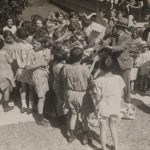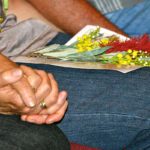Not just paper: the importance of ‘non-traditional’ records
- Oct 22, 2015
- In Features
Back in March 2014, when we used to publish a regular Find & Connect newsletter, our former Lead Archivist, Mike Jones, wrote a piece about the importance of ‘non-traditional’ records. Mike wrote:
we must be aware that we have a collective responsibility to locate, preserve and provide access to more than just paper.
Those of us working in this field need to keep raising awareness. Case files and admission registers are critical records, but so too are paintings, walls, buildings, gardens, mementos and other objects. We must seek to preserve them, at least digitally. Such records sometimes contain more meaning and emotion than words on a page. Sometimes they are the only records left.
(These days, when he is not working on his PhD, Mike can be found blogging on Context Junky and on Twitter .)

(2012)
The ‘record’ Mike was writing about was a mural that used to exist at Magill Training Centre in South Australia. The building was demolished in January 2014. Our historians, Karen George and Gary George, had tried to get access to the site so they could photograph this mural before it disappeared. Unfortunately, with no advanced warning the mural was demolished before they could take any photographs. While this record was not made of paper, it was still an important record.
There’s a postscript to this story about the destruction of the mural at Magill. One of our SA historians, Gary George, came across a blog post in August 2014 which had photos of Magill as well as St John’s Boys Town. Gary contacted the blogger, Dave Walsh, in the hope that he might know something about the mural. A few days later, Dave replied and posted 2 images of the mural. Dave’s image is now part of the information we have about Magill on the Find & Connect web resource.
To quote Mike’s newsletter piece again:
We know via our stakeholders, Senate reports and other sources how important records are to this community. We must be aware that we have a collective responsibility to locate, preserve and provide access to more than just paper. Those of us working in this field need to keep raising awareness. Case files and admission registers are critical records, but so too are paintings, walls, buildings, gardens, mementos and other objects. We must seek to preserve them, at least digitally. Such records sometimes contain more meaning and emotion than words on a page. Sometimes they are the only records left.






Frank Golding
October 23, 2015 11:32 amI very much agree with this post. In Ballarat earlier this year, the Base Hospital handed back to Ballarat CAFS a set of painting of nursery rhymes that once hung on the walls of the Orphanage. Many former residents will have fond memories of these simple artworks that lightened up their otherwise stressful days. CAFS will include the paintings along with many other artefacts in it new Heritage Centre to be opened early in 2016. The site of the former Orphanage is now owned by private developers who have been forced kicking and screaming to accept that two modest but historic buildings along with a wall and a memorial garden will be saved from the wholesale demolition that is proposed. Former residents will be able to show their children and grandchildren something tangible from their childhoods.
Cate O'Neill
October 23, 2015 1:36 pmThank you, Frank – what a perfect example of the meaning and significance that objects can have. I look forward to visiting the CAFS Heritage Centre, and congrats to all who have lobbied so hard to save the former Orphanage.